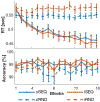Hippocampal and striatal responses during motor learning are modulated by prefrontal cortex stimulation
- PMID: 33991699
- PMCID: PMC8351752
- DOI: 10.1016/j.neuroimage.2021.118158
Hippocampal and striatal responses during motor learning are modulated by prefrontal cortex stimulation
Abstract
While it is widely accepted that motor sequence learning (MSL) is supported by a prefrontal-mediated interaction between hippocampal and striatal networks, it remains unknown whether the functional responses of these networks can be modulated in humans with targeted experimental interventions. The present proof-of-concept study employed a multimodal neuroimaging approach, including functional magnetic resonance (MR) imaging and MR spectroscopy, to investigate whether individually-tailored theta-burst stimulation of the dorsolateral prefrontal cortex can modulate responses in the hippocampus and the basal ganglia during motor learning. Our results indicate that while stimulation did not modulate motor performance nor task-related brain activity, it influenced connectivity patterns within hippocampo-frontal and striatal networks. Stimulation also altered the relationship between the levels of gamma-aminobutyric acid (GABA) in the stimulated prefrontal cortex and learning-related changes in both activity and connectivity in fronto-striato-hippocampal networks. This study provides the first experimental evidence, to the best of our knowledge, that brain stimulation can alter motor learning-related functional responses in the striatum and hippocampus.
Keywords: GABA; Hippocampus; Motor learning; Prefrontal cortex; Striatum; Theta-burst stimulation.
Copyright © 2021. Published by Elsevier Inc.
Conflict of interest statement
Declaration of Competing Interest The authors have no conflict of interest to declare.
Figures






Similar articles
-
Prefrontal stimulation prior to motor sequence learning alters multivoxel patterns in the striatum and the hippocampus.Sci Rep. 2021 Oct 18;11(1):20572. doi: 10.1038/s41598-021-99926-1. Sci Rep. 2021. PMID: 34663890 Free PMC article.
-
Baseline sensorimotor GABA levels shape neuroplastic processes induced by motor learning in older adults.Hum Brain Mapp. 2020 Sep;41(13):3680-3695. doi: 10.1002/hbm.25041. Epub 2020 Jun 25. Hum Brain Mapp. 2020. PMID: 32583940 Free PMC article.
-
Prefrontal stimulation as a tool to disrupt hippocampal and striatal reactivations underlying fast motor memory consolidation.Brain Stimul. 2023 Sep-Oct;16(5):1336-1345. doi: 10.1016/j.brs.2023.08.022. Epub 2023 Aug 28. Brain Stimul. 2023. PMID: 37647985
-
Implicit sequence learning and working memory: correlated or complicated?Cortex. 2013 Sep;49(8):2001-6. doi: 10.1016/j.cortex.2013.02.012. Epub 2013 Mar 13. Cortex. 2013. PMID: 23541152 Review.
-
Theta Oscillations Through Hippocampal/Prefrontal Pathway: Importance in Cognitive Performances.Brain Connect. 2020 May;10(4):157-169. doi: 10.1089/brain.2019.0733. Epub 2020 May 7. Brain Connect. 2020. PMID: 32264690 Review.
Cited by
-
Modulating Visuomotor Sequence Learning by Repetitive Transcranial Magnetic Stimulation: What Do We Know So Far?J Intell. 2023 Oct 13;11(10):201. doi: 10.3390/jintelligence11100201. J Intell. 2023. PMID: 37888433 Free PMC article. Review.
-
Cingulate and striatal hubs are linked to early skill learning.bioRxiv [Preprint]. 2024 Nov 21:2024.11.20.624544. doi: 10.1101/2024.11.20.624544. bioRxiv. 2024. PMID: 39803559 Free PMC article. Preprint.
-
Effective Motor Skill Learning Induces Inverted-U Load-Dependent Activation in Contralateral Pre-Motor and Supplementary Motor Area.Hum Brain Mapp. 2025 Apr 1;46(5):e70208. doi: 10.1002/hbm.70208. Hum Brain Mapp. 2025. PMID: 40186523 Free PMC article.
-
The role of inhibitory and excitatory neurometabolites in age-related differences in action selection.NPJ Aging. 2025 Mar 13;11(1):17. doi: 10.1038/s41514-025-00204-5. NPJ Aging. 2025. PMID: 40082460 Free PMC article.
-
A role for GABA in the modulation of striatal and hippocampal systems under stress.Commun Biol. 2021 Sep 2;4(1):1033. doi: 10.1038/s42003-021-02535-x. Commun Biol. 2021. PMID: 34475515 Free PMC article.
References
-
- Albouy G, King BR, Maquet P, Doyon J, 2013a. Hippocampus and striatum: dynamics and interaction during acquisition and sleep-related motor sequence memory consolidation. Hippocampus 23, 985–1004. - PubMed
-
- Albouy G, Sterpenich V, Balteau E, Vandewalle G, Desseilles M, Dang-Vu T, Darsaud A, Ruby P, Luppi PH, Degueldre C, Peigneux P, Luxen A, Maquet P, 2008. Both the hippocampus and striatum are involved in consolidation of motor sequence memory. Neuron 58, 261–272. - PubMed
-
- Albouy G, Sterpenich V, Vandewalle G, Darsaud A, Gais S, Rauchs G, Desseilles M, Boly M, Dang-Vu T, Balteau E, Degueldre C, Phillips C, Luxen A, Maquet P, 2012. Neural correlates of performance variability during motor sequence acquisition. Neuroimage 60, 324–331. 10.1016/j.neuroimage.2011.12.049. - DOI - PubMed
-
- Albouy G, Sterpenich V, Vandewalle G, Darsaud A, Gais S, Rauchs G, Desseilles M, Boly M, Dang-Vu T, Balteau E, Degueldre C, Phillips C, Luxen A, Maquet P, 2013b. Interaction between Hippocampal and striatal systems predicts subsequent consolidation of motor sequence memory. PLoS One 8, 12–14. - PMC - PubMed
Publication types
MeSH terms
Substances
Grants and funding
LinkOut - more resources
Full Text Sources
Other Literature Sources

